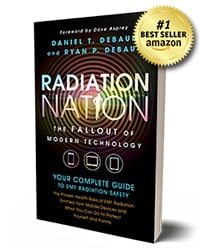Your cart is currently empty!

What is SAR and What are SAR Limits on Electromagnetic Radiation?
Last Updated on October 3, 2023

About SAR (Specific Absorption Rate)
SAR, or Specific Absorption Rate, is a measure of the amount of Radio Frequency (RF) Electromagnetic Fields (EMFs) absorbed by the human body when using an electronic device.
This rate is measured as the power absorbed within a defined area of body tissue in a standard measurement of watts per kilogram (W/kg).
SAR can be an average measure over the entire body, or a small sample amount. What you get is the greatest level measured in a defined area of the body.
SAR measures exposure within the frequency range of 100 kHz and 10 GHz which includes electronic devices such as laptops, tablets, WiFi routers and cell phones.
The value is highly dependent upon the body parts being tested, energy levels and the proximity to the radiating source.
The SAR value is established by selecting areas of the body to be tested, finding the highest absorption rate while exposing that area closest to the radiating source.
There are guidelines for SAR established by national and international organizations.
For example, below are SAR requirements for cell phones, set in 1993, which became adopted by the Federal Communications Commission (FCC) in 1996. Back then, only a small fraction of the population were using cell phones, and only for minutes of the day.
SAR Guidelines
United States SAR Limits
In the US, the Federal Communication Commission (FCC) requires that cell phones have a SAR level at or below 1.6 watts per kilogram (W/kg) taken over a volume containing a mass of 1 gram (g) of tissue.
European Union SAR Limits
The EU has set SAR limits for mobile phones (and other such hand-held devices), to be less than or equal to 2 W/kg averaged over 10 g of tissue.
Related Posts
None found



























